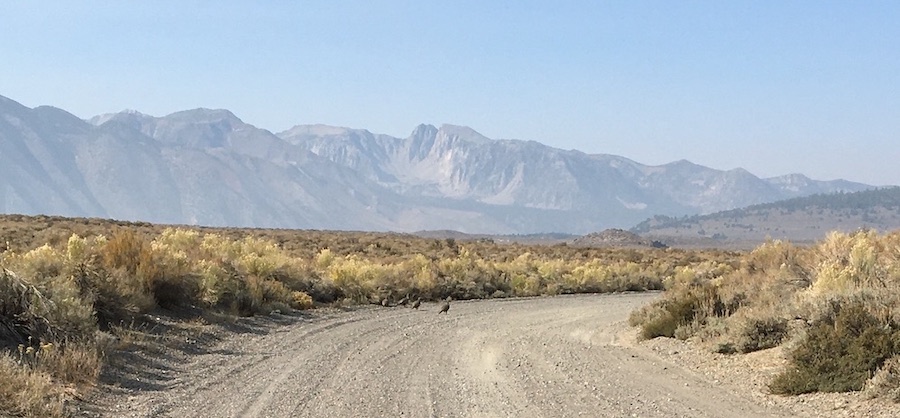Bi-State Sage-Grouse Population Declines 40%

Sage grouse crossing the road Photo credit: L. Boulton
The January 2022 USGS Annual Data Summary draft report on the bi-state sage-grouse population from 2008 to 2021 indicates the population declined 40% since 2008—a drop of 1,539 sage-grouse. The median total number of birds is estimated at 2,282. The report provides substantial quantitative analysis of the population decline based on bird tracking, monitoring, and translocation. Because there are natural variations in the population size—with more birds in good precipitation years and fewer in low precipitation years—a model was used to determine the overall trend. In the 2018 integrated population modeling update, the model showed that looking back 24 years, the population increased by 57.7 from 1995, but looking back 18 or 11 years, the total population has decreased by 15.7 and 9.6 percent respectively since then. The question is, will the population increase again or will it continue the current downward trend?
The bi-state birds are a distinct population segment of the greater sage-grouse. The bi-state sage-grouse includes nine subpopulations in California and Nevada. The authors conclude the primary cause of the decline is the years of drought starting in 2012. Other factors are range contraction and raven predation. Of the nine subpopulations, the following seven declined:
- Pine Nuts
- Fales
- Mount Grant
- Sagehen
- Long Valley
- Desert Creek
- White Mountains
The Bodie Hills population was stable. The report postulated that the reason that the Bodie Hills subpopulation remained relatively stable compared with other subpopulations is the cooler, more drought resistant habitat, and a better environment for the grouse. The Parker Meadows subpopulation increased because hens from the Bodie Hills were translocated to it during a 4-year period. Prior to that the subpopulation was critically low due to a high percentage of infertile eggs and the lack of genetic diversity.
Of particular interest is the translocation project from Bodie Hills to Parker Meadows. There were 47 sage-grouse translocated between 2017 and 2019; 27 females and 20 males. Of the 47, 34 were confirmed dead post-translocation. Seven of the mortalities were because of predators and 1 from a vehicle.
Initially, pre-nesting females were moved, but of the 27 pre-nesting females, 3 died within 16 days. Five initiated a nest. The next year post-nesting females were moved with their chicks which proved to be much more successful. Of the 28 females and 149 chicks, 26 and 147 survived the translocation process. This indicates substantially more success in translocating females post-nesting. A few grouse got home sick—12% returned to their capture site in Bodie Hills and 7% relocated to the Sagehen site.
The study also monitored the number of avian predators in 2019 and 2021 paying particular attention to the number of raptors and ravens when livestock was present versus when it was not. Ravens eat the eggs of the sage-grouse.
Sage-grouse in the road. Photo credit: L. Boulton
"As of spring 2021, the Long Valley subpopulation represents 31 percent of all sage-grouse within the Bi-State DPS."[1] Historically it was the largest subpopulation representing over 40 percent of the total population. Drought is one factor in the decline, but the proximity to the dump, which supports a raven population, and the influx of human activity are also factors as anthropogenic disturbances to sage-grouse are high at Long Valley compared to the other subpopulations. Although the effect of outdoor recreation pressure on sage-grouse has not been quantified, field crews have documented several nests less than 10 meters from well-traveled roads and have documented domestic dogs and camp sites near active nests. This type of disturbing encroachment would be greatly amplified by the proposed exploratory drilling in and around lekking areas. Drilling may take place this year starting July 1, after the mating and early nesting period; even though, there has been substantial organizational and public opposition to the project.
In 2013, US Fish and Wildlife Service (USFWS) listed the bi-state sage-grouse as a candidate species as threatened under the Environmental Species Act. In 2015, the USFWS decided to not list the bi-state sage-grouse. However, the species was reinstated as a candidate species in May 2022 by the U.S. District Court, Northern District of California.
By Kristine Green
[1] Greater Sage-grouse (Centrocercus urophasianus) Monitoring in the Bi-state Distinct Population Segment, California-Nevada, 2008-21